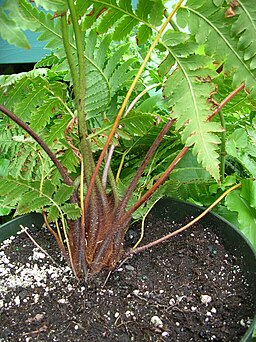The main characteristics of pteridophytes are:
-
Pteridophytes are mostly terrestrial sometimes growing in the moist and shady regions. Whereas some are aquatic like Azolla. Salvinia. The innhabitants of dry land are Selaginella rupestris, Selaginella lepidophylla, Equisetum arvens etc.
-
Pteridophytes shows large variation in the form, size and habit. It ranges from the small annuals to the large tree like perennial forms.
-
The plant body is differentiated into root, stem and leaves.
-
The prominent plant body is sporophytic and represents the dominant phase in the life cycle. The sporophyte which is nutritionally independent of the gametophyte.
-
Plants are either homosporous (eg. Equisetum, Lycopodium, Pterium) or heterosporous (eg. Selaginella, Marsilea, Salvinia).
-
The leaves vary from the simplest form to the compound nature. On the basis of the nature of leaves the pteridophytes are classified into:
i. Microphyllous pteridophytes,
ii. Macrophyllous pteridophytes.
-
The stem is usually branched; branching is monopodial or dichotomous.
-
The leaves and stem possess filliform trichomes. Stomata are present on both the upper and lower surface of the leaf.
-
The young leaves are coiled in nature.
-
It possesses underground horizontally growing stems called rhizomes.
-
The primary roots are soon replaced by the adventitious roots having permanently growing apex.
-
The stele is a protostele (Lycopodium, Selaginella) Siphonostele (Equisetum, Ophioglossum pendulum) dictyostele (Pteris, Nephrolepis) or polycyclic (Angiopteris).
-
The root and stem possess a well-developed vascular system having the xylem and phloem. The cambial ring is absent so the secondary growth does not occurs.
-
The leaves bearing sporangia are known as sporophylls. The sporophylls with megasporangia are called megasporophyll and with microsporangia are called microsporophyll.
-
Pteridophytes have spore producing leaves or sporophylls; the spots are called sori.
-
Pteridophytes reproduce by spores which are produced in the sporangia. The sporangia is borne on the usually on the ventral surface of the leaves. In one member Ophioglossum a fertile spike is present.
-
Pteridophytes are known as the vascular cryptogams i.e. seedless vascular plants.
-
The ferns are diploid sporophyte.
-
The embryo of pteridophytes is classified into exoscopic embryo and endoscopic embryo.
-
Large variation is also observed in the shape of gametophyte; in the homosporous pteridophytes the prothallus is simple, green and hearts shaped or also possess aerial branches.
-
Life cycle of pteridophytes is diplobiontic.
-
It exhibits heteromorphic alternation between the gametophytic and sporophytic generation. That is morphologically distinct sporophytic and gametophytic generation.
-
In heterosporous species; the microspores give rise to the male gametophyte and megaspore give rise to the female gametophyte.
-
In the homosporous pteridophytes antheridia and the archegonia are borne on same prothallus.
-
Water is essential for fertilization.
-
Presence of protective jacket cells in the sex organs.
-
Vegetative propagation in pteridophytes occurs by fragmentation and budding.